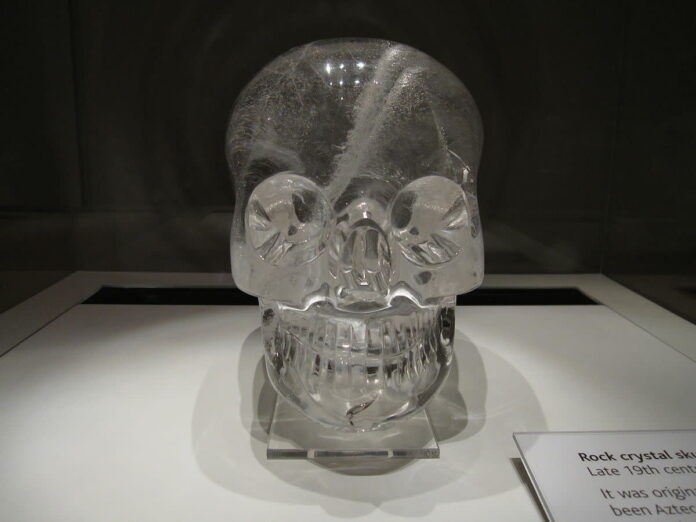Some of the most mysterious artifacts on our planet are the crystal skulls of the Maya. One of them even inspired the plot of the fourth Indiana Jones movie. What are these artifacts, and what is their history?
The Mysteries of the Maya
The first mentions of crystal skulls found in South America date back to the late 19th century. The renowned archaeologist Eugène Boban discovered a small skull in Guatemala in 1878, measuring just 10 centimeters in height. In 1889, Mexican soldiers found another artifact, which was the size of an average human head. It is now displayed at the British Museum.
Another well-known skull was found by archaeologist Albert Mitchell-Hedges in 1927 during excavations of a city built during the time of the Maya civilization. Initially, it was found without its jaw, but the jaw was discovered three months later. The jaw can be attached to the skull using special hinges while retaining its mobility.
The most recent of the skulls was found not in South America but in Germany, and its jaw was damaged. Historians claim that it belonged to Heinrich Himmler. It is now known that the Nazis hunted for rare artifacts, to which they attributed mystical powers. Apparently, the German special services, including the “Ahnenerbe” organization, found it in America and secretly transported it to Europe.
Their Value
Even today, it is very difficult, if not impossible, to manufacture such skulls. The “Mitchell-Hedges Skull” has been studied in the most detail. It was found to be made from a single piece of rock crystal. This is a very hard material that can only be worked with diamond tools. Even more surprising is that there are no deposits of such solid crystal in South America! Moreover, the analysis showed a high purity of the substance. There are no inclusions of other materials in the crystal, and its crystalline structure is flawless.
There are also interesting psychological effects observed when in contact with the artifacts. For example, Mitchell-Hedges’ daughter, Anna, who was 17 years old, once fell asleep next to the skull her father had found. In her sleep, she saw vivid images of the pre-Columbian civilizations’ lives. Her father was shocked by her stories—she mentioned such details that could have been known to him, a scholar who had spent years studying the Maya, but not to his teenage daughter! Moreover, if the skull was in another room, Anna had ordinary dreams, but when she fell asleep next to the artifact, strange visions returned.
Other unusual properties of these objects are also known. One of the owners claimed that the skull helped her get rid of brain cancer, and another owner allegedly used it to predict fluctuations in the value of securities on the stock market. However, these claims are not documented.
In the Maya chronicles, mentions of 13 crystal skulls have been found. Allegedly, they possess immense magical power, and if all of them are brought together, access to all the knowledge of our universe, including the future, can be obtained. The indigenous people feared the power of the artifacts and kept them in different cities so that no one could unite their power, but for some reason, they did not dare to destroy them.
The Maya themselves wrote in their chronicles that the skulls are significantly older than their civilization. For instance, experts from the “Ahnenerbe” believed they were about 12,000 years old and were made by Atlanteans. Another version suggests their extraterrestrial origin—supposedly, aliens brought them to Earth 35-50 thousand years ago. Interestingly, around the same time, there was a “linguistic explosion” when people mastered speech, almost as complex as the modern level.
How Many Skulls Exist?
Although Maya legends clearly indicate 13 artifacts, there are several more in the world, ranging from 21 to 49 according to various sources. The discrepancy arises because some craftsmen made forgeries, which were later passed off as originals and sold for large sums of money. However, today there is a certain consensus in scientific circles about which skulls are genuine. Nine of them are held by private collectors, and four can be seen in the following museums:
– The British Museum (which houses 2 skulls);
– The Museum of Primitive Art in Paris;
– The National Museum of Natural History of the Smithsonian Institution (Washington).
Skeptics’ Opinion
Some scientists believe that all these skulls were created in the 19th or 20th century. In particular, Eugène Boban, who owned his own antique shop and traded in artifacts of pre-Columbian civilizations, is accused of falsification.
Microfractures of carborundum, a material that began to be used in industry only in the 20th century, have been found on some skulls. However, this fact only confirms that the Maya themselves could not have created such a complex object. Nonetheless, it can be speculated that the skulls were created by an unknown, highly advanced civilization that was familiar with carborundum.
